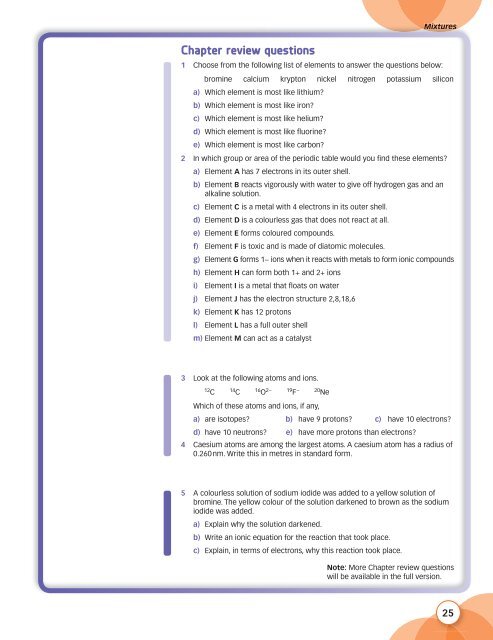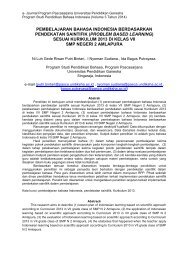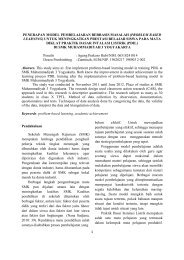Create successful ePaper yourself
Turn your PDF publications into a flip-book with our unique Google optimized e-Paper software.
Chapter review questions<br />
Mixtures<br />
1 Choose from the following list of elements to answer the questions below:<br />
bromine calcium krypton nickel nitrogen potassium silicon<br />
a) Which element is most like lithium?<br />
b) Which element is most like iron?<br />
c) Which element is most like helium?<br />
d) Which element is most like fluorine?<br />
e) Which element is most like carbon?<br />
2 In which group or area of the periodic table would you find these elements?<br />
a) Element A has 7 electrons in its outer shell.<br />
b) Element B reacts vigorously with water to give off hydrogen gas and an<br />
alkaline solution.<br />
c) Element C is a metal with 4 electrons in its outer shell.<br />
d) Element D is a colourless gas that does not react at all.<br />
e) Element E forms coloured compounds.<br />
f) Element F is toxic and is made of diatomic molecules.<br />
g) Element G forms 1− ions when it reacts with metals to form ionic compounds<br />
h) Element H can form both 1+ and 2+ ions<br />
i) Element I is a metal that floats on water<br />
j) Element J has the electron structure 2,8,18,6<br />
k) Element K has 12 protons<br />
l) Element L has a full outer shell<br />
m) Element M can act as a catalyst<br />
3 Look at the following atoms and ions.<br />
12 C 14 C 16 O 2− 19 F − 20 Ne<br />
Which of these atoms and ions, if any,<br />
a) are isotopes? b) have 9 protons? c) have 10 electrons?<br />
d) have 10 neutrons? e) have more protons than electrons?<br />
4 Caesium atoms are among the largest atoms. A caesium atom has a radius of<br />
0.260 nm. Write this in metres in standard form.<br />
5 A colourless solution of sodium iodide was added to a yellow solution of<br />
bromine. The yellow colour of the solution darkened to brown as the sodium<br />
iodide was added.<br />
a) Explain why the solution darkened.<br />
b) Write an ionic equation for the reaction that took place.<br />
c) Explain, in terms of electrons, why this reaction took place.<br />
Note: More Chapter review questions<br />
will be available in the full version.<br />
25





